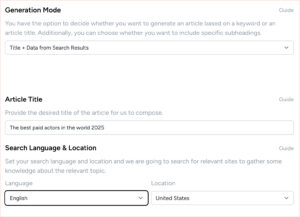To be able to find out what to pay a writer, you need to know four numbers:
- How many words per month the writer produces
- Cost of checking for plagiarism
- The full salary of a writer
- Overhead costs associated with an employee.
Considering above, the pay of a writer is around 10-20¢ per word (without proofreading). Let’s have a look at how we calculated this number.
Amount of words produced by the writer
This one is fairly easy. If you don’t know this already, just have the writer create a spreadsheet with the articles they have written and how many words each article is. Sum it up and you have the number. If you want to have the articles proofread before published, (highly recommended) you have to do the same thing with the amount of words proofread.
Cost of checking for plagiarism
It’s very important that the text you publish online is unique. This is because of how Google works. If your text is not unique, Google will not show it and your investment in the content will be wasted.
A big part of the writing process is research. When doing a lot of research, it’s easy to accidentally phrase things in a way that Google won’t think is unique enough. The only way to make sure that the text is unique is to use automated software. The software compares the text to every text published online. There are plenty of good services out there that do this (we use Copyscape for this) and they charge a small fee. This fee should be included in your cost per word analysis.
Luckily, it’s very cheap to do this and adding this cost seems silly (we will reveal the price for it further down, and then you’ll understand what we mean). The reason we still include this cost is because it’s an extremely important step in the process. If you are not doing this step, checking for uniqueness, you are playing with fire.
The full salary what to pay to a writer
There is a reason why we write “full salary” and not just salary. When you get an employee, you need to pay additional salary related expenses which are calculated as a percentage on top of the salary.
This includes:
- Vacation time and holidays
- Sick Days
- Social security
This varies a lot depending on which country you are based in. Some welfare states have high social security costs (up to 32%-40% on top of the employees’ salary) whilst others have lower costs.
For vacations and sick days, a good rule of thumb is to add an extra month of salary per year. Or 8.33% on top of the salary. This is being conservative, because you also need to pay the employee for public holidays.
Overhead costs of an employee
There are three types of overhead: Direct, Indirect and Management.
Direct overhead of an employee
The direct overhead costs are things like a computer, a monitor, an office chair or health contributions. For us in Malta this came out to around €100/employee and month.
Indirect overhead of an employee
The indirect are actually the easiest ones to calculate, so let’s start with them. Just take all your overhead costs from last month’s profit and loss sheet and divide it by the number of employees.
Indirect overhead costs include amongst other things:
- Utilities (water, gas, electricity, internet)
- Office
- Furniture
- Food and Beverages (coffee is a good investment in productivity)
- Software and service subscriptions
- Transportation
- Office supplies
- Office management
- Legal and accounting fees
When we had a large office in Malta (before we decided to become a remote-first company) our monthly overhead costs were approximately €9000 for an office of 18 people. The indirect costs for a writer in our office was in this case €9000 divided by 18 = €500.
Management overhead of an employee
Everybody who has had more than one employee knows that everybody needs a manager. If it’s not you, it’s a manager or HR that you need to hire.
- Salary of Human Resources Manager
- Salary of the direct manager of the employee
In our case in Malta, our content producing staff of 18 had one dedicated HR and two managers. Their salaries should be divided by 18. In our case that came out to an extra €555 per employee for the indirect overhead.
What to pay a writer: example calculation
1. Amount of written words = 42,000 / month
Let’s say you hired a really good writer who knows the topic. He can produce 2,000 words per day. A standard working month is 21 days which means 42,000 words in a month.
2. The amount of words proofread = 84,000 per month
Proofreading is faster. A good proofreader should be able to proofread twice as many words as a writer can produce. Meaning 4000 words per day or 84,000 words per month.
3. Cost of checking for plagiarism = €5
The cost of checking for plagiarism is low. Copyscape Premium charges: 3¢ per search (up to 200 words) plus 1¢ per extra 100 words. The cost for 500 words is on average about 5 cents (depending on how many words each article is). So for 40,200 words it would only be about €5.
4. The average monthly salary cost = €3,250
The full salary of the employee depends on which country you are based in. Let’s say you are based in France and have hired a writer for €2500/month in gross salary. We add 8,33% for vacations and sick days and social contributions of 20% as social contributions.
5. Overhead costs of an employee = €100 + €500 + €555 = €1155
When it comes to overhead employee costs, it depends on how generous you are with new equipment and how much management needs to be involved. Let’s use our example from Malta: Direct Overhead = €100, Indirect overhead = €500, management overhead = €555.
Cost per word of a full-time writer calculation
To calculate the cost per word, we just multiply the costs and divide that number with the word count.
(5+3250+1155) / 42,000 = 0.105 EUR/word without proofreading.
Proofreading text before publishing it is highly recommended. The added cost of that would be
5+3250+1155=4 305 /84,000 = 0.0525 EUR/word.
Cost = 0.105 + 0.0525 = 0.1575 EUR/word including proofreading.
If you are based in a country with higher taxes and standard of living (I’m looking at you Nordic countries) this price/word would be even higher.
If your writer can produce half as much, 1000 words per day, your costs would be:
- 0.210 EUR/word without proofreading
- 0.315 EUR/word with proofreading
You should hire a full-time writer when
- You are confident you are able to find a skilled and high producing writer willing to work for the above-mentioned salary.
- You enjoy the challenges of finding and moving to a bigger office.
- You have a continuous and stable need of exactly 84,000 words per month.
- That need is only in one language (or “per language”).
- There are no fluctuations in the amount of text needed.
- There is no fluctuation in which language you need your texts in.
- You can afford to wait one month to have the text delivered.
A more flexible approach to content creation: Topcontent
If your need for text varies over the year, you don’t want the extra overhead costs and you don’t know yet which languages will give you the most traction in the coming months, then you should look for a more flexible solution.
At Topcontent we offer a solution that will give you the flexibility of scaling up and down depending on your needs. And you can choose among a huge variety of languages and even use our content translation services to translate already written text into new ones.
Benefits of outsourcing content creation to Topcontent
- Instant access to lots of professional writers, without having to recruit
- No management or office overhead
- Enjoy quick deliveries, of massive amount of content
- Scale up and down depending on your needs
- High flexibility when it comes to languages and markets
- All text guaranteed unique
- Keep exact track of costs with the help of our simple pricing structure
- Access to technical features that allows for Automated Content Publishing
Our cost of written and proofread text starts at 0.06 EUR per word. Check out our easy-to-understand price list for content.
We achieve this lower cost not by reducing the quality, but by having state of the art writing software that helps the writers and proofreaders to be more efficient. It automatically checks for rules and corrects mistakes. For example, you can decide exactly which paragraph should contain a keyword or where links should go. This system greatly increases our writers’ output and we pass that savings on to you.
Sounds too good to be true? Sign up and check it out!






